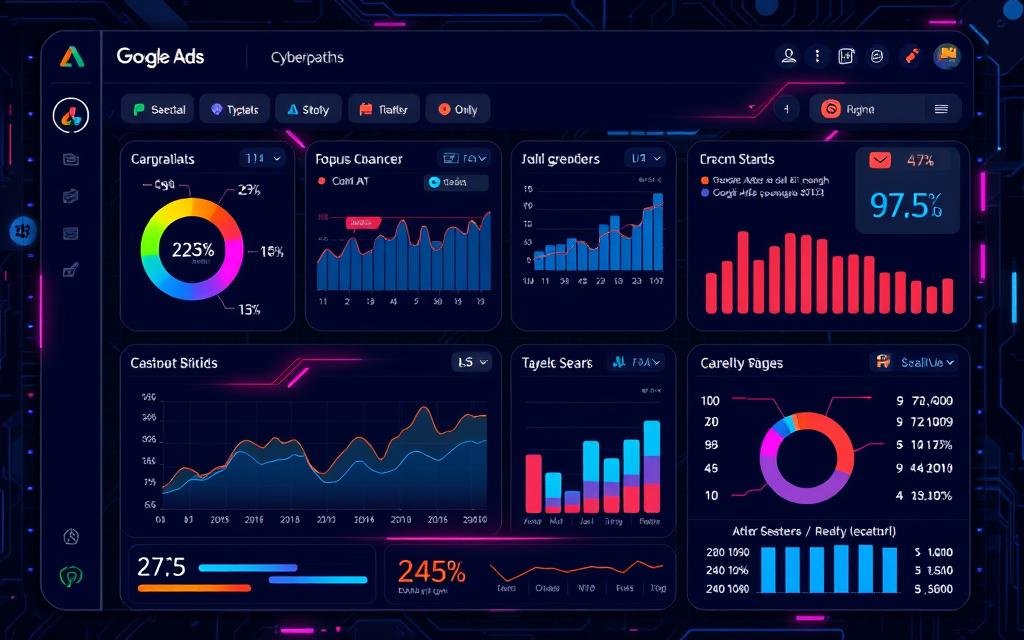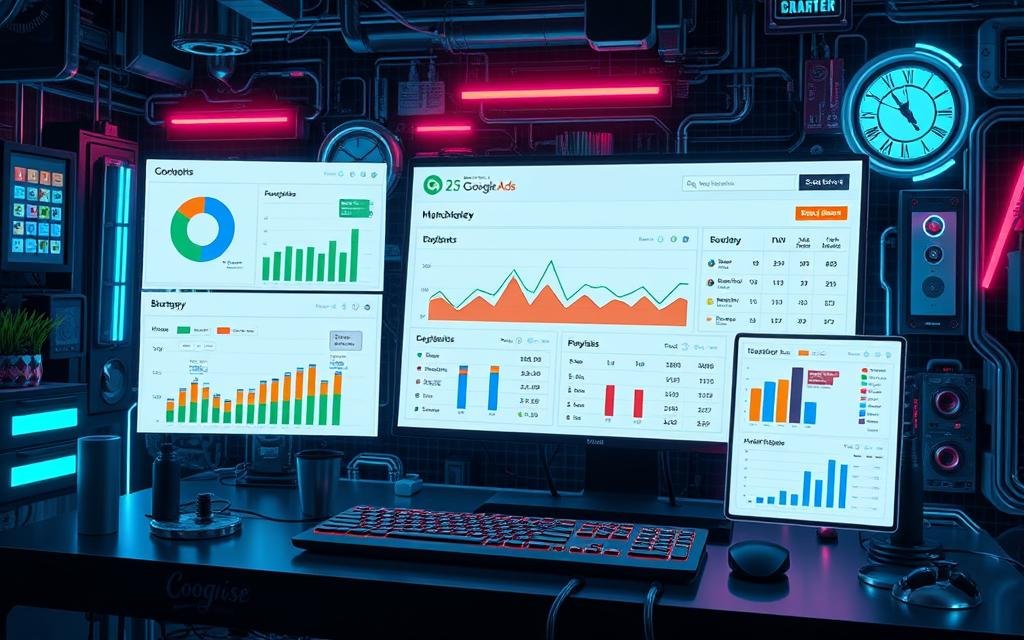Managing your monthly budget effectively is crucial when it comes to Google Ads campaigns. A well-allocated budget can significantly enhance your return on investment (ROI) by ensuring that your ads reach potential customers at the right time.
Many businesses struggle with allocating their Google Ads budget efficiently, leading to wasted ad spend and missed opportunities. Understanding how to choose right campaign settings and optimize your budget is key to success.
By optimizing your budget and selecting the right campaign type, such as Performance Max, you can improve your campaign’s performance and achieve a better ROI. This article will explore key strategies to help advertisers maximize their ROI through effective budget management.
Understanding Google Ads Budget Fundamentals
Effective Google Ads budget management starts with understanding the fundamentals. Google Ads allows advertisers to set monthly budget caps that can be adjusted at any time, providing flexibility in managing ad spend.

How Google Ads Spending Works
Google Ads operates on an auction system, determining when and where your ads appear based on your budget settings and other factors. The platform’s technology helps measure results and maximize ad spend efficiency.
Daily vs. Monthly Budget Allocation
Advertisers can choose between daily and monthly budget allocation. Daily budgets offer more control, while monthly budgets provide flexibility. Google’s algorithm distributes your budget across days to maximize results based on potential traffic.
As
“The key to successful Google Ads budget management is understanding how your budget is being spent and making adjustments accordingly.”
By grasping these fundamentals, advertisers can optimize their Google Ads campaigns for better ROI.
Setting Realistic Budget Goals Based on Business Objectives
To maximize ROI, it’s essential to set realistic budget goals based on business objectives. This involves understanding your marketing goals and aligning your Google Ads spend accordingly.
Aligning Ad Spend with Marketing Goals
Your Google Ads campaign type selection should be based on your marketing goals, brand strategy, and available time investment. For instance, if your goal is direct sales, you’ll want to allocate your budget differently than if you’re focusing on brand awareness. As a marketer once said,
“The key to successful advertising is not to spend money, but to spend it wisely.”
Calculating Your Initial Google Ads Budget
To calculate your initial Google Ads budget, consider your target cost-per-acquisition and desired conversion volume. For your first campaign, it’s crucial to select based marketing goals. This will help you determine the optimal budget allocation. For example, if you’re running a campaign focused on lead generation, you’ll need to allocate your budget based on the cost of acquiring leads.

Choosing the Right Campaign Types for Maximum ROI
Google Ads offers various campaign types, each designed to meet specific business objectives and maximize ROI. Understanding these options is crucial for selecting the best fit for your business goals.
Performance Max Campaigns
Performance Max campaigns leverage Google’s AI to optimize across multiple channels like YouTube, Discover, and Search, maximizing conversions. They are ideal for businesses seeking to boost their online presence across Google’s ecosystem.
Search Ads for Direct Response
Search Ads are perfect for driving sales, leads, or site traffic by targeting users actively searching for products or services. They provide immediate conversions from high-intent users.
Display and Video Ads for Brand Awareness
Display and Video Ads help build brand awareness through visually engaging content. While they may not drive immediate conversions, they contribute to long-term ROI.
Shopping Ads for E-commerce
Shopping Ads are designed for e-commerce businesses, showcasing product listings to potential customers. They are effective for driving sales and maximizing product visibility.
By understanding and leveraging these campaign types, businesses can significantly enhance their ROI on Google Ads.
Budget Distribution Strategies Across Campaigns
To achieve optimal results, it’s essential to allocate your Google Ads budget wisely across campaigns. Effective budget distribution enables you to maximize ROI, reach potential customers at different stages of their buying journey, and capitalize on high-demand periods. Google Ads can help find potential customers interested in products or brands like yours, making strategic budget allocation crucial.
Prioritizing High-Performing Campaigns
Identifying and prioritizing high-performing campaigns is vital for maximizing ROI. By analyzing campaign performance data, you can determine which campaigns deserve increased budget allocation. The 70/20/10 budget rule is a useful framework: allocate 70% to proven performers, 20% to promising campaigns, and 10% to experimental initiatives. This approach allows you to balance risk and reward while optimizing your Google Ads campaigns.
Testing and Scaling Budget Allocation
Testing and scaling budget allocation is critical to finding the optimal spending level for each campaign. By incrementally increasing or decreasing budgets, you can identify the sweet spot before hitting diminishing returns. This process enables you to refine your budget distribution strategy, ensuring that you’re reaching potential customers effectively and maximizing your ROI. As stated by Google, “Google Ads Audiences helps reach people based on their passions or topics they’re actively researching,” making it essential to allocate your budget accordingly.

Leveraging Google’s AI for Budget Optimization

By harnessing the power of Google’s AI, advertisers can significantly enhance their budget allocation strategies. Google’s AI-powered ad solutions help take marketing further by finding new customers, building creative, unlocking performance opportunities, and multiplying business results.
Smart Bidding Strategies
Smart Bidding strategies use machine learning to optimize for conversions or conversion value in each auction. Strategies like Target CPA, Target ROAS, and Maximize Conversions allow for effective budget utilization.
Automated Budget Adjustments
Automated budget adjustments work by dynamically allocating budget to high-performing campaigns. Understanding when to trust the system and when to implement manual overrides is crucial for optimal results.
Tracking and Measuring ROI in Google Ads
To maximize ROI with Google Ads, it’s crucial to track and measure campaign performance effectively. Google Ads offers conversion tracking to get unmatched audience insights, helping businesses capture new customer opportunities with the highest ROI.
Setting Up Conversion Tracking
Setting up conversion tracking in Google Ads involves a step-by-step process to accurately measure return on ad spend. This includes identifying valuable customer actions and linking them to your Google Ads campaigns, enabling data-driven decisions.
Key Performance Metrics to Monitor
To measure Google Ads ROI effectively, monitor key performance metrics such as ROAS (Return on Ad Spend), CPA (Cost Per Acquisition), conversion rate, and attribution metrics. These metrics provide insights into campaign performance and help in optimizing budget allocation.
Using Attribution Models Effectively
Different attribution models can significantly affect your perception of campaign performance and budget allocation decisions. Google Ads provides various attribution models to help you understand how different touchpoints contribute to conversions, enabling more informed decision-making.
![]()
Budget Management Tools and Features in Google Ads

To optimize your Google Ads campaigns, understanding the available budget management tools is essential. Google Ads provides a variety of features to help advertisers manage their budgets effectively.
Budget Reports and Insights
Google Ads offers detailed budget reports that provide insights into your ad spend. These reports help identify areas of wasted spend and opportunities for optimization.
Forecasting and Planning Tools
The platform also includes forecasting tools that allow you to predict the impact of budget changes before implementing them. This helps in making informed decisions about your Google Ads budget.
Common Budget Management Mistakes to Avoid
To achieve a better ROI with Google Ads, understanding and avoiding common budget management mistakes is essential. Effective budget management involves more than just setting a budget; it requires continuous monitoring and adjustments to optimize performance.
Underspending in Profitable Campaigns
One critical mistake is underspending in profitable campaigns. Allocating too little budget to high-performing campaigns can limit their potential and result in missed opportunities. New advertisers can choose between different offers based on their budget to jumpstart their first campaign, with terms and conditions applying to these offers, including ad credits after meeting minimum spend requirements.
Ignoring Seasonal Trends
Another mistake is ignoring seasonal trends. Failing to adjust budgets according to seasonal fluctuations can lead to either wasted spend during low seasons or missed opportunities during peak periods. Advertisers should analyze historical data to anticipate and prepare for these trends.
Neglecting Mobile Budget Allocation
Neglecting mobile budget allocation is also a significant oversight. With a substantial portion of users accessing Google Ads through mobile devices, ensuring adequate budget allocation for mobile campaigns is crucial. Advertisers should review user behavior and conversion patterns to allocate their budget effectively between desktop and mobile campaigns.
By being aware of these common mistakes and taking steps to avoid them, advertisers can significantly improve their Google Ads campaign performance and achieve a better ROI. As Google Ads continues to evolve, staying informed about best practices and leveraging tools like Smart Bidding and automated budget adjustments can further enhance campaign efficiency.
Advanced Budget Optimization Techniques
To maximize ROI, advertisers need to go beyond basic campaign-level adjustments and implement advanced budget optimization techniques in Google Ads. These techniques enable advertisers to fine-tune their budget allocation and improve campaign performance.
Dayparting and Scheduling
Dayparting involves adjusting bids based on the time of day or day of the week to maximize conversions during high-performing periods. By concentrating budget during these periods, advertisers can improve their ROI. For instance, a business may find that its ads perform better during lunch hours or late evenings.
Geographic Bid Adjustments
Geographic bid adjustments allow advertisers to allocate more budget to locations that drive better results. By adjusting bids based on location, advertisers can ensure that their ads are seen by users in high-converting areas. This technique is particularly useful for businesses with a strong local presence.
Audience Segmentation for Budget Efficiency
Audience segmentation involves targeting specific user groups based on their behavior, demographics, or interests. By focusing budget on user groups with the highest conversion potential, advertisers can improve their ROI. Google Ads allows for audience segmentation based on relevant keywords and websites, enabling advertisers to deliver more relevant ads and achieve better goals.
Conclusion: Creating a Sustainable Google Ads Budget Strategy
A well-planned Google Ads budget strategy can significantly enhance your campaign’s performance and overall ROI. To achieve this, it’s essential to summarize key principles: align ad spend with marketing goals, prioritize high-performing campaigns, and leverage Google’s AI for optimization. Continuous testing and learning are crucial, rather than adopting set-and-forget budget strategies. By doing so, you can reach potential customers effectively and drive business growth. Implement at least one new budget optimization technique to improve campaign performance and stay competitive.

I really like reading through a post that can make men and women think. Also, thank you for allowing me to comment!
This is really interesting, You’re a very skilled blogger. I’ve joined your feed and look forward to seeking more of your magnificent post. Also, I’ve shared your site in my social networks!